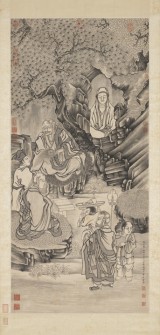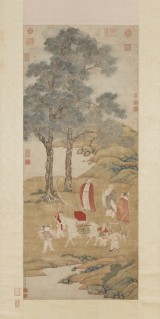TELDAP Collections
| Images of the Mind Borne from the Brush: The Paintings of Ding Yunpeng |
|
Introduction Ding Yunpeng (style names Nanyu and Wenju; sobriquets Shenghua jushi and Huangshan laoqiao) was a native of Xiuning in Anhui. Though painting catalogues and historical records do not mention his birth and death dates, his extant paintings indicate that he was born in 1547 and still alive in 1628. His father, Ding Zan, was a doctor by profession and fond of collecting, being also gifted at painting and calligraphy. Steeped in such a family background, Ding Yunpeng took up the brush and came to specialize in painting. He often visited and studied under Zhan Jingfeng while associating at one time or another with the likes of such noted contemporaries in the arts as Dong Qichang, Chen Jiru, Mo Shilong, and Wang Zhideng, having the opportunity to view and study the works of Song and Yuan dynasty masters in their collections, thereby providing even further inspiration in his painting. With Ding's gift at poetry and painting along with his devotion to Buddhism, the Buddhist figures he depicted appear particularly spirited and radiant. Therefore, Dong Qichang not only likened Ding Yunpeng to the great Tang dynasty poet-painter Wang Wei, he even praised Ding as "unparalleled over the past three centuries." The landscapes, figures, and flowers done by Ding Yunpeng were all exquisite, but most of his works seen today deal with landscape and figure subjects. His landscape painting is similar to the methods used in the Wu School, harking back to masters of the Song and Yuan dynasties. His early works feature delicate brushwork and dense compositions with elegant coloring that still reflect traces of the literati painter Wen Zhengming. The use of brush and ink in Ding's later works, however, tends to be loftier and more mature, the compositions often arranged in a somewhat unusual manner all his own. In figure and Buddhist painting, his style traces back to the traditions of the Tang and Song dynasty masters Wu Daozi and Li Gonglin, and he was also gifted at the manners of the Five Dynasties painters of Buddhist arhats Guanxiu and Zhang Xuan, creating a style of his own. The drapery lines in Ding Yunpeng's early works are round and refined, being compared to floating clouds and flowing water. Complemented by light and refined colors, every detail of his delicate works is full of expression and character. After the mid-1590s, Ding's style underwent a change as his brushwork became looser with lines more abbreviated and vigorous. His forms, along with coarse brushwork and dark ink, became exaggerated and the rendering increasingly eccentric. This transformational painting style, in which he chose "the awkward over the clever and the ugly over the enchanting," became a new pioneering manner in the waning of figure and religious painting in the late Ming dynasty. This exhibition features representative examples of landscape and Buddhist painting by Ding Yunpeng from various periods over his career, providing a complete overview of the development of his transformational painting style and the diversity of his forms of expression.
Selections
A cascade appearing like a bolt of silk is highlighted against layers of ridges and clusters of trees. The composition is mostly full and the mountains done in "ox-hair" texture strokes, the brush method archaic and mature in a manner similar to that of Wang Meng. In terms of arrangement, the painting is also similar in places to "Lofty Mount Lu" by Shen Zhou, with even the title in three seal script characters virtually identical to Shen's. Here, however, the mountaintops are contorted into cloud-head shapes with considerable force and dynamism. The ink tones of the fore-, middle-, and background are also heavy without much differentiation in terms of darkness, thus fully revealing Ding Yunpeng's own style. This work was painted in 1599, when Ding Yunpeng was 43 years old by Chinese reckoning.
Clustered peaks soar above roiling clouds and mists amongst dense evergreen trees, where an ancient temple is tucked away. On the winding mountain path a scholar chants as he slowly walks accompanied by an attendant. The brushwork throughout this work is quite varied with fine strokes delineating the pines for a strong and archaic manner. Short texture strokes using a dry brush render the complex ridges of the distant mountaintop, while large texture strokes define a cliff by the temple. A dry brush with dark ink was also used for the jagged rocks of the foreground. The hoary strength of the brush and ink is complemented by light ochre coloring, imbuing an air of elegance to the dense scenery. The entire work is filled with power and vigor, the composition dense but without the slightest sense of being overpowering, making this a masterpiece of Ding Yunpeng's landscape painting. This work was done in 1614, when Ding Yunpeng was 68 years old by Chinese reckoning.
A stream winds down through scenery as a child attendant sits on and washes a white elephant. A bodhisattva also sits to the side and watches. The character for "elephant" in Chinese is a homonym for "form," so the title here actually suggests "sweeping away forms," a Buddhist expression that means to clear one's mind of attachment to all things. The figures in this painting were rendered with a centered brush, the drapery lines refined like floating clouds and flowing water that seem to unfold with natural grace. Every detail of the figures is done with exceptionally fine brushwork. Although the brushwork here is similar to the "baimiao" fine-line manner of Li Gonglin, Ding Yunpeng has gone further by adding colors, creating a manner all his own. The contorted features of the trees in the background, along with the dense dotting of the vegetation and elegant coloring, all reveal the influence of the Wen School of painting. This work, dated to the equivalent of 1588, comes from when Ding Yunpeng was 42 years old by Chinese reckoning.
Gathering of Lohans Among precipitous cliffs in a forest of ancient trees is a gathering of lohans in various activities and poses, such as quietly sitting in meditation, reading from scriptures, and taming a dragon and tiger. The forms of many lohans are based on those of Guanxiu, emphasizing their foreign Indian background. Here, though, Ding Yunpeng has added a background of rocks and trees. By also having the figures interact with each other, Ding has created a lohan handscroll painting combined with such favored literati themes as a landscape and figures resting on rocks and trees. This work was done in relatively darker ink with coarse brushwork, the leaves varied but having a strong decorative effect. The signature at the end is dated to the equivalent of 1596, when Ding Yunpeng was 50 years old by Chinese reckoning. This being the earliest dated example of Ding's lohan painting in coarse brushwork, it is especially significant in understanding the development of his later style.
The subject of sixteen lohans was a favorite religious theme depicted by Ding Yunpeng. In late spring of 1613, when Ding was 67 by Chinese reckoning, he did four paintings of lohans at a monk's dwelling on Tiger Hill in Suzhou, with each work depicting four lohans. The four works are now all in the collection of the National Palace Museum, with this being one of them. Of the four lohans in this painting, one sits with eyes closed in meditation within a grotto, another concentrates chanting a sutra, one holds rosary beads, and another grasps a fly whisk as he teaches. The figures' heads are all large in proportion to their bodies, and their expressions appear exaggerated. The drapery lines are stiff and angular, the mountain and tree forms all rendered in dark ink. The brushwork is strong and hoary, the tree leaves outlined with fine lines, and the work strongly decorative. Overall, an awkward manner permeates the painting.
Emperor Mingdi of the Han dynasty sent Cai Yin to India to acquire Buddhist scriptures (sutras). Two years later, the Indian monks Dharmaratna and Kāśyapa-mātavga came to China from western regions bringing sutras on a white horse. This painting illustrates the story of a white horse carrying sutras. This work painted in 1625 is a masterpiece by Ding Yunpeng from the Chinese age of 79. Generally speaking, Ding's late religious works were mostly done in monochrome ink with coarse brushwork. This painting, however, features fine brushwork and colors, marking a return to his earlier painting style. Close examination of the trees reveals straight trunks with few knots and a sketchy rendering of the leaves, with only light ink and vegetable green used in layers of dots and washes. The drapery lines are also strong and archaic. In other words, this work is an abbreviated variation on Ding's early fine painting style creating exceptional elegance.
Text and images are provided by National Palace Museum
|
















